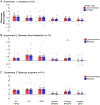Lack of selectivity for syntax relative to word meanings throughout the language network
- PMID: 32569894
- PMCID: PMC7483589
- DOI: 10.1016/j.cognition.2020.104348
Lack of selectivity for syntax relative to word meanings throughout the language network
Abstract
To understand what you are reading now, your mind retrieves the meanings of words and constructions from a linguistic knowledge store (lexico-semantic processing) and identifies the relationships among them to construct a complex meaning (syntactic or combinatorial processing). Do these two sets of processes rely on distinct, specialized mechanisms or, rather, share a common pool of resources? Linguistic theorizing, empirical evidence from language acquisition and processing, and computational modeling have jointly painted a picture whereby lexico-semantic and syntactic processing are deeply inter-connected and perhaps not separable. In contrast, many current proposals of the neural architecture of language continue to endorse a view whereby certain brain regions selectively support syntactic/combinatorial processing, although the locus of such "syntactic hub", and its nature, vary across proposals. Here, we searched for selectivity for syntactic over lexico-semantic processing using a powerful individual-subjects fMRI approach across three sentence comprehension paradigms that have been used in prior work to argue for such selectivity: responses to lexico-semantic vs. morpho-syntactic violations (Experiment 1); recovery from neural suppression across pairs of sentences differing in only lexical items vs. only syntactic structure (Experiment 2); and same/different meaning judgments on such sentence pairs (Experiment 3). Across experiments, both lexico-semantic and syntactic conditions elicited robust responses throughout the left fronto-temporal language network. Critically, however, no regions were more strongly engaged by syntactic than lexico-semantic processing, although some regions showed the opposite pattern. Thus, contra many current proposals of the neural architecture of language, syntactic/combinatorial processing is not separable from lexico-semantic processing at the level of brain regions-or even voxel subsets-within the language network, in line with strong integration between these two processes that has been consistently observed in behavioral and computational language research. The results further suggest that the language network may be generally more strongly concerned with meaning than syntactic form, in line with the primary function of language-to share meanings across minds.
Keywords: Cognitive neuroscience; Composition; Language architecture; Lexical semantics; Syntax.
Copyright © 2020 Elsevier B.V. All rights reserved.
Conflict of interest statement
Declaration of competing interest The authors declare no competing financial interests.
Figures







Similar articles
-
Lexico-semantics obscures lexical syntax.Front Lang Sci. 2023;2:1217837. doi: 10.3389/flang.2023.1217837. Epub 2023 Aug 9. Front Lang Sci. 2023. PMID: 38549784 Free PMC article.
-
An Attempt to Conceptually Replicate the Dissociation between Syntax and Semantics during Sentence Comprehension.Neuroscience. 2019 Aug 10;413:219-229. doi: 10.1016/j.neuroscience.2019.06.003. Epub 2019 Jun 11. Neuroscience. 2019. PMID: 31200104 Free PMC article.
-
Seeing words in context: the interaction of lexical and sentence level information during reading.Brain Res Cogn Brain Res. 2004 Mar;19(1):59-73. doi: 10.1016/j.cogbrainres.2003.10.022. Brain Res Cogn Brain Res. 2004. PMID: 14972359
-
Neural mechanisms of language comprehension: challenges to syntax.Brain Res. 2007 May 18;1146:23-49. doi: 10.1016/j.brainres.2006.12.063. Epub 2006 Dec 23. Brain Res. 2007. PMID: 17400197 Review.
-
Sentence processing is uniquely human.Neurosci Res. 2003 Jul;46(3):273-9. doi: 10.1016/s0168-0102(03)00122-6. Neurosci Res. 2003. PMID: 12804788 Review.
Cited by
-
Deep Artificial Neural Networks Reveal a Distributed Cortical Network Encoding Propositional Sentence-Level Meaning.J Neurosci. 2021 May 5;41(18):4100-4119. doi: 10.1523/JNEUROSCI.1152-20.2021. Epub 2021 Mar 22. J Neurosci. 2021. PMID: 33753548 Free PMC article.
-
Behavioral Signatures of Memory Resources for Language: Looking beyond the Lexicon/Grammar Divide.Cogn Sci. 2022 Nov;46(11):e13206. doi: 10.1111/cogs.13206. Cogn Sci. 2022. PMID: 36353955 Free PMC article.
-
Differential Tracking of Linguistic vs. Mental State Content in Naturalistic Stimuli by Language and Theory of Mind (ToM) Brain Networks.Neurobiol Lang (Camb). 2022 Jul 14;3(3):413-440. doi: 10.1162/nol_a_00071. eCollection 2022. Neurobiol Lang (Camb). 2022. PMID: 37216061 Free PMC article.
-
Spatiotemporally distributed frontotemporal networks for sentence reading.Proc Natl Acad Sci U S A. 2023 Apr 25;120(17):e2300252120. doi: 10.1073/pnas.2300252120. Epub 2023 Apr 17. Proc Natl Acad Sci U S A. 2023. PMID: 37068244 Free PMC article.
-
The language network as a natural kind within the broader landscape of the human brain.Nat Rev Neurosci. 2024 May;25(5):289-312. doi: 10.1038/s41583-024-00802-4. Epub 2024 Apr 12. Nat Rev Neurosci. 2024. PMID: 38609551 Review.
References
-
- Abeillé A, Hemforth B, Winckel E, & Gibson E (2020). Extraction from subjects: differences in acceptability depend on the discourse function of the construction. Cognition. - PubMed
-
- Aguirre GK, & Farah MJ (1998). Human visual object recognition: What have we learned from neuroimaging?. Psychobiology, 26(4), 322–332.
-
- Amalric & Dehaene S (2018). A distinct cortical network for mathematical knowledge in the human brain. Neuroimage. - PubMed
-
- Ambridge B, Pine JM, Rowland CF, Freudenthal D, & Chang F (2014). Avoiding dative overgeneralisation errors: semantics, statistics or both? Language Cognition and Neuroscience, 29(2), 218–243.
-
- Ambridge B (2018). Against stored abstractions: A radical exemplar model of language acquisition. First Language, 0142723719869731.

